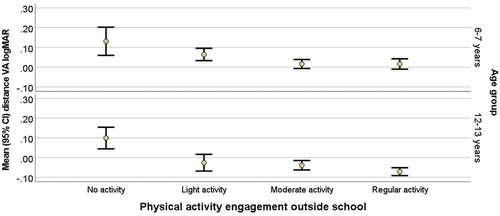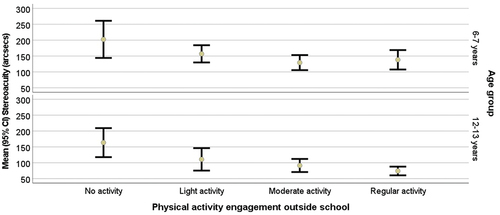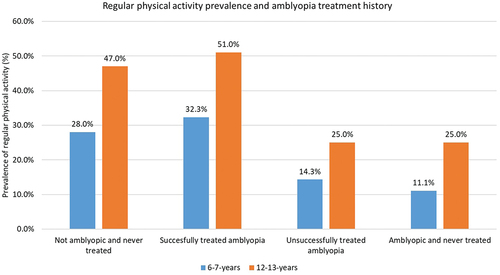Figures & data
Table 1. The relationship between engagement in physical activity stratified by age in 723 6-7-years-old and 887 12-13-years-old participants and sociodemographic factors.
Figure 1. Mean logMAR distance vision in the better eye by physical activity category in 6-7-year-olds (top image) and 12-13-year-olds (bottom image). Higher logMAR acuity scores represent poorer vision.

Table 2. The relationship between engagement in physical activity stratified by age in 723 6-7-years-old and 887 12-13-years-old participants and presenting visual acuity (distance 3 m and near 40 cm), presenting stereoacuity, and amplitude of accommodation.
Figure 2. Mean stereoacuity by physical activity category in 6-7-year-olds (top image) and 12-13-year-olds (bottom image). A higher stereoacuity reading represents poorer stereoacuity.

Table 3. The relationship between engagement in physical activity stratified by age in 723 6-7-years-old and 887 12-13-years-old participants and various aspects of visual function, (presenting visual impairment, amblyopia, refractive error and history of spectacle wear).
Figure 3. Prevalence of regular physical activity (>3 hrs/week) amongst 723 participants aged 6-7-year-old and 887 participants aged 12-13-year-old by amblyopia treatment history category: not amblyopic and no history of amblyopia treatment, previously amblyopic successfully treated for amblyopia, amblyopic and unsuccessfully treated, and amblyopic participants never treated.

Table 4. Odds ratio for visual factors associated with no physical activity controlling for confounders (socioeconomic status and ethnicity) in 1,610 participants (723 aged 6-7-years and 887 aged 12–13 years) in the Ireland Eye Study.
